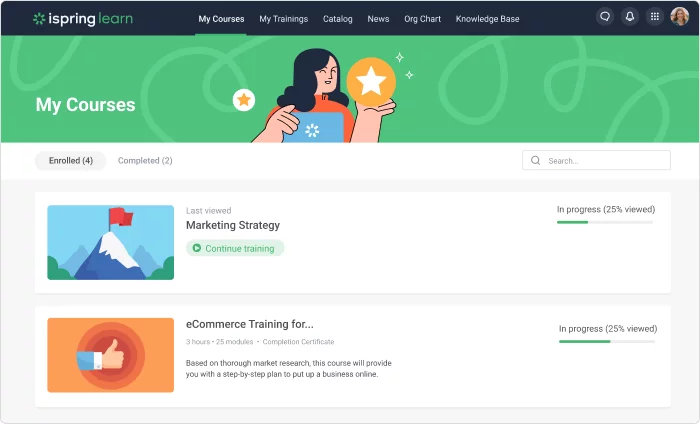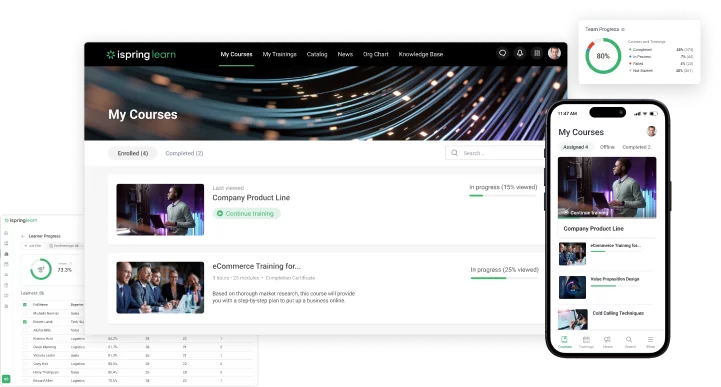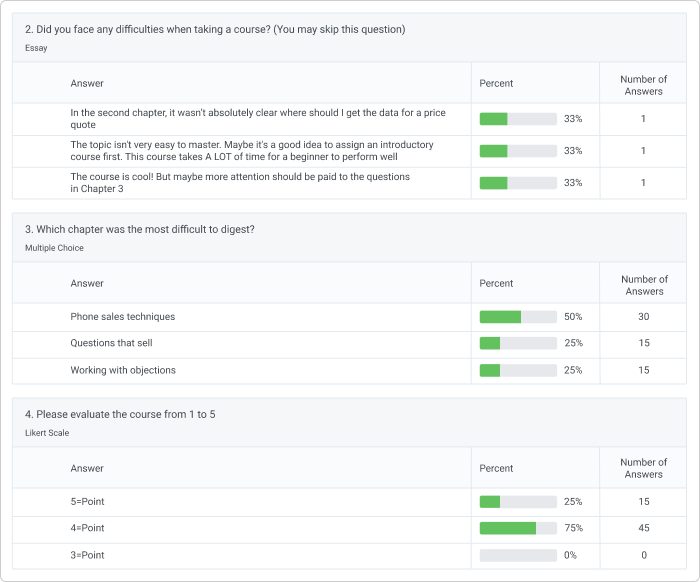What Is Technical Training?

Technical training is a crucial element of both a successful organization and people’s careers. Technical skills form the basis of any specific role leading to the importance of continual upskilling in order to acquire and develop these skills. If you want to increase employee productivity and performance, you may need to launch technical training.
In this article, we will look at what technical training is, the benefits of technical training programs, what technical skills are in demand, and the training methods for technical training programs.
Why Is Technical Training Important?
Technical training is professional learning that applies to specific roles or tasks. Sometimes referred to as “hard skills,” these are the skills needed for performing tasks that constitute their job.
Whether upskilling or reskilling, technical training enables employees to learn new roles or enhance their existing ones. Technical skills are obviously essential for new employees entering a position that requires specialized knowledge, but continuous technical training programs are equally valuable.
Types of Technical Training

Formal education
Specialized jobs require employees to first get academic qualifications from institutions such as vocational schools, colleges, and universities.
Long, intensive programs such as degrees, diplomas, and other certificates ensure that employees develop the basics and are proficient in their field. Formal education ultimately forms the basis of technical training.
On-the-job training
Many organizations provide some degree of on-the-job training. Usually delivered by employees with experience, such as supervisors, this kind of training focuses on technical tasks that can be perfected while already fulfilling a role.
On-the-job training is essential for harnessing and sharing the experience and knowledge of senior employees within the organization and across different departments.
Online courses and certifications
The internet provides countless opportunities for self-development, both for employees and employers. A vast array of technical skills can be taught via online learning and are available at different prices.
Online courses are often flexible and convenient, allowing both individuals and companies to access quality training at any budget. Moreover, online courses can range from being incredibly simple to being intricate and comprehensive.
Corporate training programs
In-house training programs are a mainstay of large businesses. Whether they use external or internal instructors, these programs range from short, job-specific workshops to long-term training programs.
Corporate training programs allow organizations to develop employee skills across the entire company, are tailored to specific industry factors, and can be an opportunity to implement business goals.

Benefits of Technical Training
For employees:
- Greater employability. Continual technical training makes employees more employable, helping to maximize career opportunities and job security. Moreover, an employee who is willing to learn is an employee that every company desires.
- Increased job satisfaction. Regular technical training is linked to higher levels of professional engagement, increases personal value, and reduces the likelihood that an employee feels inadequate.
For organizations:
Higher productivity. Put simply, employees who undergo technical training are better at their jobs. Effective investment in technical training programs for employees will result in higher levels of performance, workplace productivity, and reduced errors.
Talent attraction and retention. While providing high-quality training programs to your employees may seem like a surefire way to send them back into the job market, the opposite is actually true.
Any highly talented or ambitious worker, the kind that an organization will want to hire and retain, will expect a certain level of personal investment from their employers.
A business can attract and keep the best employees with the promise of developing their technical skills through training programs.
Examples of In-Demand Technical Skills
Keeping up with the latest industry trends is essential for both companies and individuals. This is why technical skills boost your career and ensure that a company meets its targets. Here are 4 in-demand technical skills that will get you hired and please managers.
Cybersecurity
Cybersecurity is perhaps the most in-demand technical skill across multiple industries right now. With the skills and knowledge to keep an organization’s networks secure, you will always be employed.
For companies and institutions, it is essential to hire individuals with hands-on experience in cybersecurity or to improve the workforce by giving them the right tools to perform this role through an effective course.
With iSpring Suite, cybersecurity is just one of the many technical skills that can be taught in an impactful and efficient manner. Moreover, iSpring also has a huge collection of pre-made technical skill training modules that you can employ.
Here is a demo course on Cybersecurity created with iSpring Suite:
Finance
Being able to track an organization’s financial performance is a much desired skill. With technical training in finance, you will be an invaluable asset for any organization to manage its finances.
There are a number of technical tasks that form the core of any financial management job in any industry, all of which are required for a business to meet its goals and sustain growth.
Data science
Many industries are in need of talented people with skills in data science, which is not surprising considering the explosion of data available in the last decade. As such, data-related skills are not restricted in their usefulness to a single career path.
As these skills are not job specific but can elevate performance across multiple departments and areas, they are highly sought after by recruiters and managers alike. Expert data analysis is a must for businesses to decide almost anything in any situation.
Marketing
Technical training in marketing is obviously necessary for a career in the field, but is also a transferable set of skills for countless jobs. Skills in marketing can get you hired to give guidance to teams developing a product or making an ad perform as desired. Marketing skills are sought after all over the world.
Selling products is the mainstay of any business. So, training sales skills is a must. A technical training program can bring ads that promote interaction, define a brand, or support new ways to improve revenue.
Here’s an example of an online course on marketing tips created with iSpring Suite:
How to Create an Effective Technical Training Program
Understandably, the biggest challenge for a business is how to create an effective technical training program with no prior experience. Below is a six-step guide on how to plan, build, and deliver effective technical training.

Read also: How to Create a Training Module: A Step-by-Step Guide
1. Identify technical training needs
The first step is to work out what training is needed. This might be based on the implementation of new technology, such as new software training, updated methods, or modern machinery.
Other needs could be higher degrees of productivity, addressing knowledge gaps, onboarding new employees, or reacting to regulatory changes.
Whatever the requirements, information is needed for this step. Sometimes it can be obvious what training is needed, but other times, a simple survey or observation in the workplace can provide the answer.
In some cases, competitive analysis is required to determine the need to deliver technical training.
2. Determine technical training objectives
With the training needs identified, it can seem like unnecessary admin to then set training goals, but don’t be misled. Setting clear and measurable training objectives is a paramount step in the process. By analyzing and prioritizing your training needs, you will arrive at your goals.
The first important thing for training objectives is that they should clearly communicate the benefits for both the company and employees. This will ensure that both parties maintain the right level of investment in the process.
Next, the goals should be SMART, which stands for:
- Specific
- Measurable
- Achievable
- Relevant
- Time-bound
3. Develop or source the technical training program
Now comes the time to develop your training program relative to your objectives for maximizing business success. There are many places you can outsource your technical training, whether it’s external instruction or online platforms.
Perhaps the most effective course of action is to leverage employee training software in order to design your own technical learning experience for employees. Not only can these software applications be used to create materials, but also to develop and deliver the entire process.
One such option is the iSpring LMS, an entirely integrated training software that allows you to effortlessly onboard, upskill, and deliver compliance, product, and other technical training to employees.

The benefit of using a platform like iSpring LMS is that it makes the entire process of designing and implementing technical training simple and effective. iSpring LMS turns these complex processes into attainable solutions for businesses to implement.
4. Create the technical training content
Once you have the platform for your training program, you now need to create learning content or choose from existing materials. Creating content that makes the learning process engaging is not always easy; that’s why it’s a great idea to employ an authoring toolkit.
iSpring Suite is a comprehensive learning authoring toolkit that allows you to create diverse and interactive training content to keep learners engaged. Such tools are designed to reduce the need for expertise and integrate training creation and delivery into a single product.
When you build educational material, it’s important to remember a few key principles:
- Choose interactive methods. Interaction in learning is vital for effective development. Training is more memorable and enjoyable if learners are given the opportunity to get involved with the process.
- Use diverse media. Spoken and written words convey a lot of information, but can become boring and challenging to remember. Using video-based training courses is a great way to captivate your audience.
- Assessments. As with any form of education, it is vital that you conduct regular testing to keep tabs on each learner’s knowledge from start to finish. Assess employees’ ability to complete tasks, and test new skills with measurable outcomes.
5. Deliver a training program
Now it’s time to deliver the technical training. When you use a solution like iSpring LMS, you have access to a complete learning management system equipped with all the features required for effective training.
iSpring LMS allows you to build and manage training content and effortlessly carry out training with an emphasis on flexibility. The software also provides detailed analytics, so you can measure the impact of your training within the organization. And this brings us to the final step of technical training implementation.

6. Measure training effectiveness
Once your training program has been implemented, it is crucial that you assess the effectiveness of your training. The success of the training program will be measured entirely against the objectives set out at the start. This will determine if both the company and the trainees feel the experience was successful.
An LMS helps you to conduct reaction surveys and collect user feedback. You can create surveys directly in the system and easily review the answers, eliminating the need to handle paper forms.

Another important reason for this analysis is the improvement of future training. Learning from mistakes and repeating success is a simple formula for building good practices.
Challenges and Solutions in Technical Training
Technical training is no walk in the park; it can present real challenges to any employer. These challenges can include:
- Lack of learner engagement
- Poor skill development
- Issues with schedules
- Return on money invested (ROI)
In order to overcome these challenges, it’s a good idea to spend adequate time employing the following solutions any time you plan to teach technical skills:
- Create engaging content with appropriate elements.
- Invest in quality training and follow guidance.
- Ensure that students have time to attend training.
- Evaluate training performance.
The Role of Soft Skills in Technical Proficiency
While technical skills are the mainstay of any productive workforce, soft skills are crucial for employee efficiency. Every single job can be done better by implementing soft skills, such as communication skills, fostering a collaborative environment, and promoting effective teamwork.
Resources and Tools for Technical Training
There are many resources and tools that you can use to train technical skills. What matters is finding the right ones for your specific needs. We’ve already looked at the examples of the iSpring LMS and iSpring Suite, and they’re a great bundle to kick-start your technical training.
For businesses looking to take full advantage of the many benefits of technical training, iSpring LMS offers a 30-day free trial to get started with everything you need to deliver impactful and effective technical training programs for employees.





